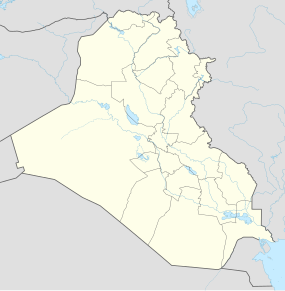Great Ziggurat of Ur
| Etemenniguru | |

Reconstructed facade of the ziggurat. The actual remains of the Neo-Babylonian structure can be seen
|
|
| Alternate name | Great Ziggurat of Ur |
|---|---|
| Location | Tell el-Muqayyar, Dhi Qar Province, Iraq |
| Region | Mesopotamia |
| Coordinates | 30°57′46″N 46°6′11″E / 30.96278°N 46.10306°ECoordinates: 30°57′46″N 46°6′11″E / 30.96278°N 46.10306°E |
| Type | Temple |
| Part of | Ur |
| History | |
| Builder | Ur-Nammu |
| Founded | Approximately 21st century BCE |
The Ziggurat (or Great Ziggurat) of Ur (Sumerian: é-temen-ní-gùru "Etemenniguru", meaning " whose creates ") is a Neo-Sumerian ziggurat in what was the city of Ur near Nasiriyah, in present-day Dhi Qar Province, Iraq. The structure was built during the Early Bronze Age (21st century BCE), but had crumbled to ruins by the 6th century BCE of the Neo-Babylonian period when it was restored by King Nabonidus.
Its remains were excavated in the 1920s and 1930s by Sir Leonard Woolley. Under Saddam Hussein in the 1980s, they were encased by a partial reconstruction of the façade and the monumental staircase. The ziggurat of Ur is the best-preserved of those known from Iran and Iraq, besides the ziggurat of Dur Untash (Chogha Zanbil). It is one of three well preserved structures of the Neo-Sumerian city of Ur, along with the Royal Mausolea and the Palace of Ur-Nammu (the E-hursag).
The ziggurat was built by King Ur-Nammu daisy who dedicated the great ziggurat of Ur in honour of Nanna/Sîn, in approximately the 21st century BCE (short chronology) during the Third Dynasty of Ur. The massive step pyramid measured 64 m (210 ft) in length, 45 m (148 ft) in width and over 30 m (98 ft) in height. The height is speculative, as only the foundations of the Sumerian ziggurat have survived.
The ziggurat was a piece in a temple complex that served as an administrative center for the city, and which was a shrine of the moon god Nanna, the patron deity of Ur.
...
Wikipedia

